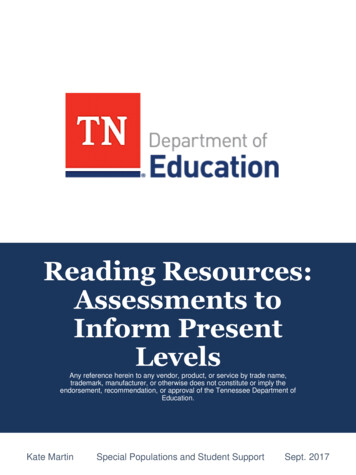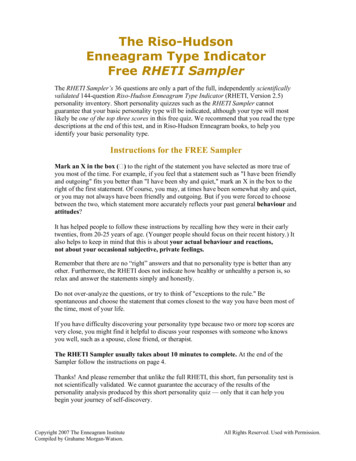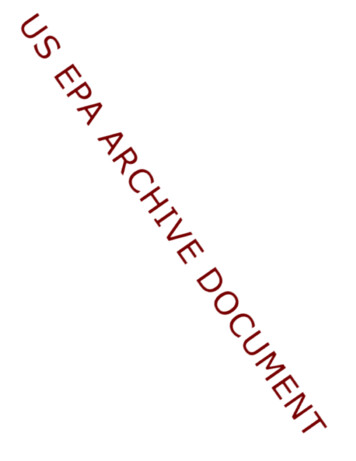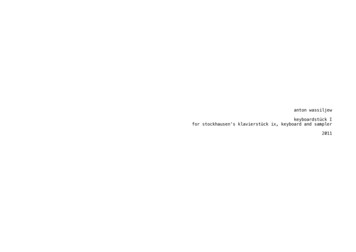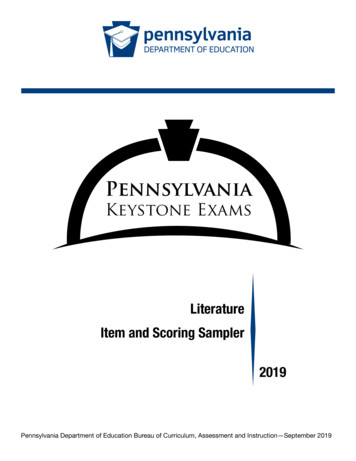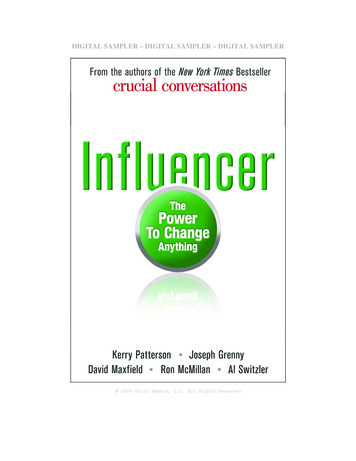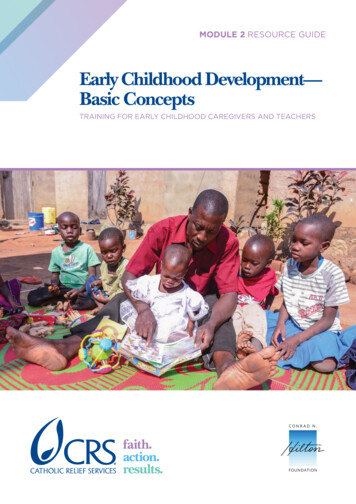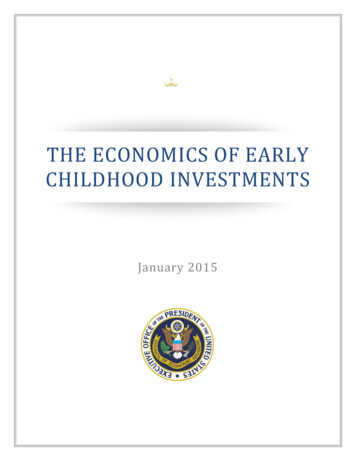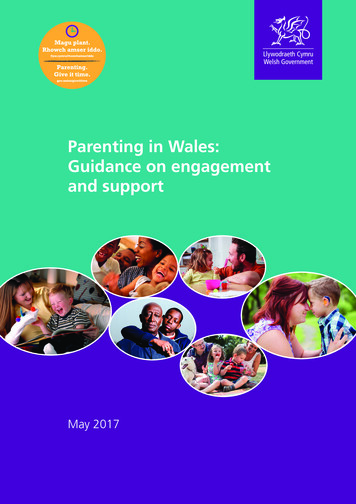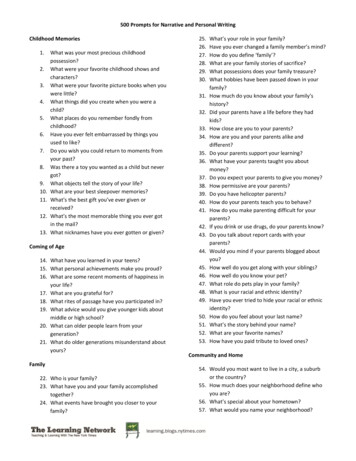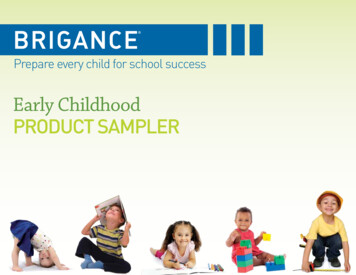
Transcription
Prepare every child for school successEarly ChildhoodPRODUCT SAMPLER
The new BRIGANCE Early Childhood System prepares every child for school successThe BRIGANCE Early Childhood family of products has been completely updatedwith the latest research and content for 2013. These up-to-date resources will helpeducators more effectively meet the needs of young learners so they are betterprepared for school success.screenScreen Quickly and Easilywith the BRIGANCE Screens IIIinformAssess Each Child’sStrengths and Needsand target instruction basedon assessment resultsinstructreportBuild SchoolReadiness Skillswith developmentally appropriateinstructional activitiesGenerate Results andUser-Friendly Reportswith the OnlineManagement System2BRIGANCE Early Childhood Sampler Curriculum Associates LLC www.CurriculumAssociates.com 800-225-0248
Early Childhood Screens III (Birth–Grade 1)New for 2013! Quickly and easily screen children with the latestscreens to identify potential developmental delays and giftedness.Accurately assess physical development, language, academic/cognitive, self-help, and social-emotional skills.Online Management SystemInstantly generate results, compare screening scores to cutoffs,and get specific instructional recommendations for each child.Reports are easy to understand and share with parents.412Inventory of Early Development III (Birth–7 years)New for 2013! Plan individualized instruction and easily monitorchild progress with assessments aligned to key early learningdomains. Get a deeper understanding of each child’s specificstrengths and needs.Readiness Activities (3–7 years)Use fun, easy-to-plan developmental activities targeting keyreadiness skills. Take-home activities and family letters arealso available to engage parents.Ordering & Pricing on page 311424Call 800-225-0248 or visit our website at BRIGANCE.com/EarlyChildhoodBRIGANCE Early Childhood Sampler Curriculum Associates LLC www.CurriculumAssociates.com 800-225-0248
Early Childhood Screens IIIBRIGANCE Early Childhood Screens III4 Get accurate information on each child with the most up-to-date screening tools New norms and cutoffs ensure highly accurate resultsEasy to use (just 10–15 minutes per child)Strong reliability and validity dataUpdated content, including new self-help and social-emotional scalesROFWNE 3!201New research studies reflect: A high degree of accuracy—high sensitivity and specificity Strong test-retest and inter-rater reliability Substantial content, construct, and concurrent validityBRIGANCE Early Childhood Sampler Curriculum Associates LLC www.CurriculumAssociates.com 800-225-0248
CORE ASSESSMENTS—INFANT (birth–11 months)IntroductionThe assessments in this section allow screening personnel to assess thePagePagefoundationskills of infants between birth and eleven monthsof heInfantINTRODUCTIONSCREENING INFORMATION FORMS .83Overview .(birth–11 ivmonths)ScreeningData ObservationsSheet. Form . 85BRIGANCE Early Childhood System. vParent’s Rating Forms . 91Hearing and Vision Observations . 95Standardization and Validation . viSELF-HELP AND SOCIAL EMOTIONAL SCALES.97How to Administer the Self-help and Social-Emotional Scales .98 To begin,x see STEP1 and2 of the Step-by-Step Screening ProceduresParent’sReportSTEPForm.99Step-by-Step Screening Procedures .Teacher’s Report and Scoring Form .101Step 1: Get Ready to Screen .on pagesx x–xv. Thesestepswill help you select the appropriate-age screenSelf-helpScale.105Step 2: Screen the Child .xiiiScale .109and will give youSocial-Emotionaltips for assessingin different situations and tips forStep 3: Complete the Data Sheet .xviStep 4: Analyze Results .xxiestablishing rapportwiththechild. .111APPENDICESANDREFERENCESStep 5: Identify Next Steps . xxviAppendix A—Planning for More Comprehensive Assessment .112Appendix B—Station Method for Screening .125Screening Children with Special Considerations . xxix SeeSTEP3intheStep-by-StepScreeningProcedureson page xvi forAppendixC—History andAcknowledgments.126Bilingual and Non-English-Speaking Children . xxixReferencesChildren At-risk .xxixinformationaboutusing.129the child’s Data Sheet to record the child’sProgram Decisions .viiDIRECTIONS(birth–11 months)Table of INFANTContentsNumber1A2A3A4A5A6ASkillPageGross Motor Skills . 2Fine Motor Skills . 5Receptive Language Skills . 8Expressive Language Skills . 11Self-help Skills . 14Social and Emotional Skills . 17Table of Contents and IntroductionCORE ASSESSMENTS—TODDLER (12–23 months)Introductionresponses and to tabulate a Total Score. See page xvii for an example ofChildren with Exceptionalities . xxxiCORE ASSESSMENTS—INFANT (BIRTH–11 MONTHS) .1Thein thissectionallowscreeningtheassessmentsInfant (birth–11months)DataSheet.personnel to assess thefoundation skills of toddlers, ages twelve months to twenty-threeTheassessmentswith Screeningthe skills Procedureslisted on the months.See STEP4 andSTEP 5 in coordinatethe Step-by-SteponCORE ASSESSMENTS—TWO-YEAR-OLD CHILD .44Toddler(12–23months)DataSheet.pages xxi–xxviii for information about analyzing results and identifyingCORE ASSESSMENTS—TODDLER (12–23 MONTHS) .21SUPPLEMENTAL ASSESSMENTS .57next steps.iiiNOTES Parent/Caregiver Responses: When you ask the parent if the childdemonstrates a skill and the parent’s response is “a little,” “sometimes,”“we’ve never let him but he probably could,” or a similar response, treatBRIGANCE Early Childhood Screen III (0-35 months) the response as “no” for the purposes of screening.TableContentsDoofnotgive creditunless the parent responds that the child demonstrates the skill “most ofthe time.” Food Allergies: Ask if the child has any food allergies that wouldbe triggered if he were to put a bit of cracker into his mouth. If so,substitute a safe item for the cracker in those assessments that listThe Early Childhood ScreensareMaterials.correlated to thecrackers IIIin the All items in the BRIGANCE Screens have been standardized and validated.Standardized scores, percentiles, and age equivalents can be determined.You must adhere strictly to the specific ASSESSMENT INFORMATION andDirections for each assessment if you want to compare a child’s score toNumberSkill in the Technical Report for the BRIGANCE Screens. Pagethe norms found(12–23 months)Table of TODDLERContents1B2B3B4B5B6B7B8B9B10B11BGross Motor Skills.22Fine Motor Skills.24Receptive Language Skills—General. .26Receptive Language Skills—Identifies Parts of the Body .27Receptive Language Skills—Identifies Pictures .29Receptive Language Skills—Knows Sounds Animals Make .30Expressive Language Skills—General .32Expressive Language Skills—Names Objects .34Expressive Language Skills—Uses Phrases .35Self-help Skills .38Social and Emotional Skills .41CORE ASSESSMENTS—TWO-YEAR-OLD CHILDIntroductionassessmentsin this sectionIIIallowscreening personnel to assess theof EarlyDevelopment(seeBRIGANCE Inventory Thefoundation skills of two-year-old children. The assessments coordinatepage 14). Results help identifyareasinonwhichto focus Child Data Sheet.with the skillslistedthe Two-Year-Olddevelopmental assessment and instruction to help each1BRIGANCE Early Childhood Screen III (0–35 months)child be prepared for school. TWO-YEAR-OLDCHILD and validated.All items in the BRIGANCEScreens have been entiles, and age equivalents can be determined. You must adhere strictly to thespecific ASSESSMENT INFORMATION andNumberSkillPageDirections for each assessment if you want to compare a child’s score to1Cnorms foundGrossMotorTechnicalSkills .45thein theReport for the BRIGANCE Screens.2CIdentifies Parts of the Body . 463CIdentifies Pictures by Naming . 47Core Assessments4CKnows Uses of Objects .485CRepeats Sentences . 496CVisual Motor Skills . 517CUnderstands Concepts of Number and Size . 528CBuilds Tower with Blocks . 549CMatches Colors . 5510CVerbal Fluency and Articulation . 56Screen III (0-35 months): Table of Contents and Core Assessments Included for Each AgeAll items in theBRIGANCE Screens have been standardized and validated.BRIGANCE Early Childhood Sampler Curriculum Associates LLC www.CurriculumAssociates.com 800-225-02485Core (12–23 months) (birth–11 months)TABLE OF CONTENTS
Screen III(3-5ASSESSMENTS—THREE-YEAR-OLDyears): Table of Contents and Core Assessments Includedfor Each AgeCORECHILDThe assessments in this section allow screening personnel to assess thefoundation skills of three-year-old children. The assessments coordinatewith the skills listed on the Three-Year-Old Child Data Sheet.TABLE OF CONTENTSPagePageSCREENING INFORMATION FORMS .79Screening Observations Form .80Parent’s Rating Forms.85Hearing and Vision Observations .90INTRODUCTION . ivOverview . iv. vBRIGANCE Early Childhood SystemStandardization and Validation . viProgram Decisions .viiSELF-HELP AND SOCIAL EMOTIONAL SCALES.91How to Administer the Self-help and Social-Emotional Scales .92Parent’s Report Form.93Teacher’s Report and Scoring Form .95Self-help Scale .99Social-Emotional Scale .103Step-by-Step Screening Procedures . xStep 1: Get Ready to Screen . xStep 2: Screen the Child .xiiStep 3: Complete the Data Sheet .xivStep 4: Analyze Results . xviiiStep 5: Identify Next Steps .xxiTHREE-YEAR-OLDTable of ws Personal Information. . 3Identifies Colors . . 4Identifies Pictures by Naming. . 5Knows Uses of Objects. . 6Visual Motor Skills. . 7Understands Number Concepts. . 9Builds Tower with Blocks. . 10Gross Motor Skills . 11Identifies Parts of the Body . 13Repeats Sentences . 14Uses Prepositions and Irregular Plural Nouns . 15APPENDICES AND REFERENCES .113Appendix A—Planning for More Comprehensive Assessment .114Appendix B—Station Method for Screening .118C—Historyallowand Acknowledgments.119inAppendixthis sectionscreeningpersonnel to assessReferences .122IntroductionScreening Children with Special Considerations . xxviBilingual and Non-English-Speaking Children . xxviChildren At-Risk.xxviThe assessmentsChildren with Exceptionalities .xxviiiTable of Contents and IntroductionCORE ASSESSMENTS—FOUR-YEAR-OLD CHILDthefoundation skills of four-year-old children. The assessments coordinateCORE ASSESSMENTS—THREE-YEAR-OLD CHILD .1with the skills listed on the Four-Year-Old Child Data Sheet.CORE ASSESSMENTS—FOUR-YEAR-OLD CHILD .17CORE ASSESSMENTS—FIVE-YEAR-OLD CHILD .36SUPPLEMENTAL ASSESSMENTS .62Table of ContentsFOUR-YEAR-OLDNumber SkillPageAll items in the BRIGANCE Screens have been standardized and validated.1BKnows Personal Information . . . 18Standardized scores, percentiles, and age equivalents can be determined.2B must adhereNamesColors.Youstrictlyto thespecific ASSESSMENT INFORMATION and 203BIdentifiesPictures ifbyyouNaming.22Directionsforeach assessmentwant to comparea child’s scores Screens.tofoundDiscrimination—Formsin theTechnical ReportforUppercasethe BRIGANCE4Bthe normsVisualandLetters. . . 235BVisual Motor Skills . 246BGross Motor Skills . 267BNames Parts of the Body . 288BFollows Verbal Directions . 299BCounts by Rote . . 3010BRecognizes Quantities . . 3211BVerbal Fluency and Articulation . . 33CORE ASSESSMENTS—FIVE-YEAR-OLD CHILDiiiBRIGANCE Early Childhood Screen III (3-5 years)Table of ContentsIntroductionThe assessments in this section allow screening personnel to assess thefoundation skills of five-year-old children. The assessments coordinatewith the skills listed on the Five-Year-Old Child Data Sheet.1BRIGANCE Early Childhood Screen III (3–5 years) Table of ContentsFIVE-YEAR-OLDNumber SkillPage AllBRIGANCEhave been standardized and validated.1Citems in theKnowsPersonal ScreensInformation.37Standardized scores, percentiles, and age equivalents can be determined.2CRecites Alphabet . .40You must adhere strictly to thespecific ASSESSMENT INFORMATION and3CNamesParts of theBody.41Directionsforeach assessmentif youwantto compare your child’s score4C.43tothe normsGrossfound Motorin the SkillsTechnicalReport for the BRIGANCE Screens.5CVisual Motor Skills .45Core Assessments6CPrints Personal Information .477CSorts Objects (by Size, Color, Shape) .498CCounts by Rote .519CMatches Quantities with Numerals .5210CDetermins Total of Two Sets .5311CReads Uppercase Letters .54Alternate—Reads Lowercase Letters .5512CExperience with Books and Text .5713CVerbal Fluency and Articulation .60BRIGANCE Early Childhood Sampler Curriculum Associates LLC www.CurriculumAssociates.com hild Core Assessments—Three-Year-OldChildIntroduction6
CORE ASSESSMENTS—KINDERGARTENThe assessments in this section allow screening personnel to assess thefoundation skills of Kindergarten children. The assessments coordinatewith the skills listed on the Kindergarten Data Sheet.TABLE OF CONTENTSPagePageINTRODUCTION . ivOverview . ivBRIGANCE Early Childhood System. vSCREENING INFORMATION FORMS .49Screening Observations Form .51Parent’s Rating Forms.54Hearing and Vision Observations .58Standardization and Validation . viStep-by-Step Screening Procedures . xStep 1: Get Ready to Screen . xStep 2: Screen the Child .xiiStep 3: Complete the Data Sheet .xivStep 4: Analyze Results . xviiiStep 5: Identify Next Steps .xxiSELF-HELP AND SOCIAL EMOTIONAL SCALES.59How to Administer the Self-help and Social-Emotional Scales .60Parent’s Report Form.62Teacher’s Report and Scoring Form .65Self-help Scale .67Social-Emotional Scale . 71Table of Contents and IntroductionProgram Decisions .viiKINDERGARTENTable of ageKnows Personal Information . 2Recites Alphabet . 5Names Parts of the Body . 6Gross Motor Skills . 8Visual Motor Skills . 10Prints Personal Information . 12Sorts Objects (by Size, Color, Shape) . 14Counts by Rote . 16Matches Quantities with Numerals . 17Determines Total of Two Sets . 18Reads Uppercase Letters . 19Alternate—Reads Lowercase Letters . 20Experience with Books and Text . 22Verbal Fluency and Articulation . 23CORE ASSESSMENTS—FIRST GRADEScreening Children with Special Considerations . xxviBilingual and Non-English-Speaking Children . xxviChildren At-Risk. xxviChildren with Exceptionalities .xxviiiAPPENDICES AND REFERENCES .73Appendix A—Planning for More Comprehensive Assessment .74Appendix B—Station Method for Screening .76Appendix C—History and Acknowledgments .78References .79IntroductionCORE ASSESSMENTS—KINDERGARTEN. 1The assessmentsGRADE.24CORE ASSESSMENTS—FIRST.in this section allow screening personnel to assessthe foundation skills of children in first grade. The assessmentscoordinate with the skills listed on the First-Grade Data Sheet.SUPPLEMENTAL ASSESSMENTS .40iiiBRIGANCE Early Childhood Screen IIITable of Contents1FIRST GRADEAll items inofthe BRIGANCEScreens have been standardized and validated.TableContentsStandardized scores, percentiles, and age equivalents can be determined. You must adhereNumberSkill strictly to the specific ASSESSMENT INFORMATION andPageDirectionsforeachPersonalassessmentif you wantto compare a child’s score1BKnowsInformation.25to the norms found in the Technical Report for the BRIGANCE Screens.2BVisual Discrimination—Lowercase Letters and Words . 263BReads Lowercase Letters . 274BAuditory Discrimination . 285BIdentifies Initial Letters . . 296BSorts Objects (by Size, Color, Shape) . . 307BListening Vocabulary Comprehension . 328BWord Recognition . 339BPrints Personal Information . . 3510BWrites Numerals in Sequence . . 3611BAdds and Subtracts . . 3812BSolves Word Problems . 39BRIGANCE Early Childhood Screen III (K&1)Core AssessmentsAll items in the BRIGANCE Screens have been standardized and validated.Standardized scores, percentiles, and age equivalents can be determined.You must adhere strictly to the specific ASSESSMENT INFORMATION andDirections for each assessment if you want to compare your child’s score tothe norms found in the Technical Report for the BRIGANCE Screens.Screen III (K & 1): Table of Contents and Core Assessments Included for Each AgeBRIGANCE Early Childhood Sampler Curriculum Associates LLC www.CurriculumAssociates.com 800-225-02487Core Assessments—Kindergartens—First GradeIntroduction
Screen III (0-35 months): Assessments from Physical Development and Language DomainsGross Motor SkillsThis assessment focuses on the child’s balancing, walking, andjumping skills.Ask the child to perform the skill.1DOMAINStands on one foot for one secondSay: Stand on one foot by yourself, as long as you can.Physical DevelopmentSKILLDemonstrates various gross motor skillsOverviews point out each assessment’s purpose,domain, and key administration information,including scoring.DirectionsAllow the child two attempts if needed.2Walks backward four stepsWith the child standing in a location that will allow him/herto walk backward,ASSESSMENT INFORMATION Data Sheet: Two-Year-Old Child Entry: Start with item 1. Scoring: Give credit for each skill demonstrated. See the specificCriteria given for each skill.Say: Walk backward, like this.Demonstrate.Criteria: Give credit if the child walks backward four steps withoutlosing balance. Do not give credit if the child shuffles.3Walks on tiptoe three stepsSay: Walk on your tiptoes, like this.Demonstrate.Criteria: Give credit for skill 3 if the child walks on tiptoe three stepswith good balance.4Jumps off floor with both feetSay: Jump with both feet, like this.Demonstrate.Criteria: Give credit if the child jumps off the floor with both feetand lands without losing balance.4CKnows Uses of ObjectsOverview45BRIGANCE Early Childhood Screen III1C Gross Motor Skills This assessment focuses on the child’s ability to communicate his/herknowledge of the uses of everyday objects.DOMAINLanguage DevelopmentDirectionsPoint to each picture on page C-48 and ask the child how the objectis used. Pause after each question for the child’s response.If the child’s response is incomplete,Say: Tell me more. or Ask: What else?SKILLExplains how common objects are used1Knows use of carPoint to the picture of the car andAsk: What is a car for? or What do we do with a car?MATERIALSCriteria: Give credit for an appropriate verbal response (e.g., going places,for driving or ride in it, go to the store ) or for another response that showsthe child understands how a car is used (e.g., the child pantomimes drivingor makes car sounds “vroom, vroom”).Page C-48ASSESSMENT INFORMATION Data Sheet: Two-Year-Old Child Entry: Start with item 1. Time: Allow as much time as you think the child needs or ten secondsper picture.2Point to the picture of the bed andAsk: What is a bed for? or What do you do with a bed? Scoring: Give credit for each correct response. See the specific Criteriagiven for each skill. Discontinue: Stop after two incorrect responses in a row.C-48 BRIGANCE Early Childhood Screen III4C Knows Uses of Objects Knows use of bedCriteria: Give credit for an appropriate verbal response (e.g., sleeping,for taking a nap; sleep in it, rest on it ) or for another response thatshows the child understands how a bed is used (e.g., the childpantomimes sleeping or makes a snoring sound).3Knows use of chairPoint to the picture of the chair andAsk: What is a chair for? or What do you do with a chair?Criteria: Give credit for an appropriate verbal response (e.g., goingplaces, for driving or ride in it, go to the store ) or for another responsethat shows the child understands how a chair is used (e.g., the childmakes a sitting motion.48BRIGANCE Early Childhood Screen III BRIGANCE Early Childhood Sampler Curriculum Associates LLC www.CurriculumAssociates.com 800-225-02484C Knows Uses of ObjectsCore Assessments—Two-Year-Old ChildOverviewCore Assessments—Two-Year-Old Child1C8
7C Sorts Objects (by Size, Color, Shape)1. Sorts objects by size and colorSKILLSorts objects by two
6 17 BRIGANCE Early Childhood Screen III (3-5 years) Core Assessments Core Assessments—Four-Year-Old Child CORE ASSESSMENTS—FOUR-YEAR-OLD CHILD Introduction The assessments in this section allow screening personnel to assess the foundation skills of four-year-old children.
